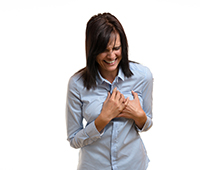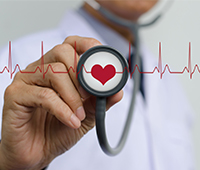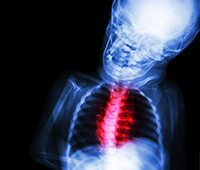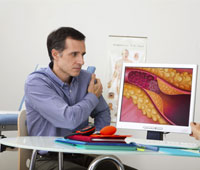WHAT IS Peripheral arterial disease
- Definition
- Causes
- Symptoms
- Diagnosis
- Ayurvedic Tips
- FAQS
- References
Definition
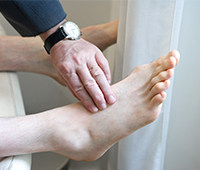
Peripheral arterial disease is similar to coronary artery disease except the fact that buildup of fatty substance happens in arteries of pheripheral parts of body - legs, stomach or arms. It is also known as peripheral vascular disease. It generally has no symptoms, but nonspecific symptoms like pain while walking or rashes can be seen which disappear with little rest. This phenomena is called intermittent claudication or constriction.1
In Ayurveda, peripheral arterial disease is described as Uttana vatarakta. When kapha and pitta dosha start accumulating in the blood channels or marga, it causes blockages (avarana). Due to this circulating vata gets affected which is called vegapratibadha leading to vatarakta and its complications. Vatarakta is an illness where both vata and rakta are affected.2
Disclaimer: The information on this page is not intended to be a substitute for professional medical advice. Do not use this information to diagnose or ayurvedic treatment of cardiology and/or peripheral arterial disease without consulting the doctor. Consult your physician before beginning an exercise regime. "While we have products /ayurvedic medicines for cardiology and/or peripheral arterial disease, you must consult an authorized physician before taking any of the products. For more information on products, visit www.dabur.com or call 1800-103-1644"
Causes
Causes OF Peripheral arterial disease
The most common cause of peripheral artery disease is atherosclerosis.
The less common cause maybe:
- Inflammation of blood vessels
- Unusual anatomy of ligaments or muscles
- Injury to limbs
- Radiation exposure.
Factors that increase the risk of developing peripheral artery disease include:
- Age more than 50 years
- Smoking
- Obesity
- Diabetes
- High blood pressure
- High cholesterol
- Family history
- High levels of homocysteine, a protein component that helps build and maintain tissue
Disclaimer: The information on this page is not intended to be a substitute for professional medical advice. Do not use this information to diagnose or ayurvedic treatment of cardiology and/or peripheral arterial disease without consulting the doctor. Consult your physician before beginning an exercise regime. "While we have products /ayurvedic medicines for cardiology and/or peripheral arterial disease, you must consult an authorized physician before taking any of the products. For more information on products, visit www.dabur.com or call 1800-103-1644"
Symptoms
Symptoms OF Peripheral arterial disease
Peripheral artery disease symptoms include:
- Painful cramping in hip, thigh or calf muscles
- Coldness in lower leg or foot
- change in the color of legs
- Shiny skin on legs
- Numbness or weakness in legs
- Sores on toes, feet or legs that won't heal
- No pulse or a weak pulse in legs or feet
- Hair loss or slower hair growth on feet and legs
- Slower growth of toenails
- Erectile dysfunction in men
Disclaimer: The information on this page is not intended to be a substitute for professional medical advice. Do not use this information to diagnose or ayurvedic treatment of cardiology and/or peripheral arterial disease without consulting the doctor. Consult your physician before beginning an exercise regime. "While we have products /ayurvedic medicines for cardiology and/or peripheral arterial disease, you must consult an authorized physician before taking any of the products. For more information on products, visit www.dabur.com or call 1800-103-1644"
Diagnosis
Diagnosis OF Peripheral arterial disease
Tests which help in diagnose of peripheral artery disease:
- Physical exam
- Ultrasound
- Angiography
- Blood tests
- Ankle-brachial index (ABI)
Disclaimer: The information on this page is not intended to be a substitute for professional medical advice. Do not use this information to diagnose or ayurvedic treatment of cardiology and/or peripheral arterial disease without consulting the doctor. Consult your physician before beginning an exercise regime. "While we have products /ayurvedic medicines for cardiology and/or peripheral arterial disease, you must consult an authorized physician before taking any of the products. For more information on products, visit www.dabur.com or call 1800-103-1644"
Ayurvedic Tips
Ayurvedic Tips Peripheral arterial disease
Tests which help in diagnose of peripheral artery disease:
- Physical exam
- Ultrasound
- Angiography
- Blood tests
- Ankle-brachial index (ABI)
Diet Recommendations (Aahar)
- Follow a Kapha-pacifying diet, which includes bitter, astringent and pungent foods.
- Include most pulses or dried beans, such as lentils and split mung dal.
- Include vegetables like broccoli, cabbage, and cauliflower and fruits such as apples and pears, amla.
- Cooked prunes and figs that may also help cleanse the bowel and lower cholesterol levels.
- Include bitter foods like spinach and mustard greens they prevent the bad type of cholesterol from accumulating.
- Avoid sweet, salty and sour foods
- Always cook food and eat it warm, to counteract the cool, earthy Kapha Dosha
- Cook with small amounts of ghee or olive oil
Lifestyle changes (Vihar)
- Regularly involve in yoga asanas like pada hastasana, Baddha konasana, setu bandha sarvangasana, utkatasana
- Yogic breathing exercises may also be beneficial
|
 Figure 1 Pada hastasana
Figure 1 Pada hastasana
Disclaimer: The information on this page is not intended to be a substitute for professional medical advice. Do not use this information to diagnose or ayurvedic treatment of cardiology and/or peripheral arterial disease without consulting the doctor. Consult your physician before beginning an exercise regime. "While we have products /ayurvedic medicines for cardiology and/or peripheral arterial disease, you must consult an authorized physician before taking any of the products. For more information on products, visit www.dabur.com or call 1800-103-1644"
FAQS
FAQS
1.What is angina?
Angina is a chest pain that occurs when the blood supply to the heart muscles is restricted. It happens when the arteries supplying the heart become hardened and narrowed due to build-up of fatty substances known as plaques. This restricts the blood supply to the heart and triggers the symptoms of angina. Angina attack is the pain mostly triggered by physical activity or stress and typically only lasts for a few minutes. There are two main types of angina. During stable angina, the attacks occur due to obvious trigger (such as exercise) and improve with medication and rest, while in unstable angina, the attacks are unpredictable, occurring with no obvious trigger and continuing despite resting. Angina is more common in older adults, affecting men more than women.
In Sanskrit, angina is derived from two words – hriday meaning ‘heart’ and shool meaning ‘thorn’. So hritshoola means ‘a thorn in the heart’. In angina, Ama accumulates in Hirdayvahi channels and cause blockage. Due to the blockage of heart channels Vata dosha is aggravated. Vata symbolizes air or wind. It is dry, mobile, and cool in nature and it causes pain in heart.
2.What can I do to prevent/manage angina?
Ayurveda gives following tips to prevent/manage angina:
- Avoid fatty foods like fried food, milk products such as butter and cheese, full cream milk, oils, etc.
- Include fermented milk products like curds in diet
- Use only vegetable oils for cooking like sunflower, olive, groundnut and rapeseed oils.
- Avoid red meats such as mutton, beef and pork.
- Poultry and fish are beneficial. Fishes with high body oil content must be preferred. Avoid canned fish.
- Mild exercise such as walking, is recommended in patients which good exertion tolerance and stable angina.
- Avoid competitive exercising.
- Meditation and shavasana help restore the tranquility, peace and manage stress
- Pranayam (breathing exercise) should be practiced.
3.What are the causes of high cholesterol?
Many different factors can contribute to high blood cholesterol. They include:
- Unhealthy diet
- Lack of exercise or physical activity
- Obesity
- Drinking excessive amounts of alcohol and smoking
- Underlying conditions like kidney disease, liver disease, hypothyroidism
- Family history of early coronary heart disease, stroke or cholesterol-related condition
4.What physical activities can help better my cholesterol?
Ayurveda recommends following activities to keep your cholesterol in check:
- Yoga asanas and surya namaskara should be performed twice daily for ten minutes each.
- Pranayama, or yogic breathing exercises, helps digestion and cleans the srotas, or channels.
- Sleeping during the day, causes the metabolism to slow and the srotas or channels to fill with Ama. Wake up before six o'clock, and avoid daytime naps.
- Eat meals at the same time every day, and plan to eat the largest meal at lunchtime, when digestion is strong.
- Eat light to avoid indigestion at night
- Transcendental Meditation technique reduces stress and improves mental clarity, making it easier to follow a healthy diet and make healthy lifestyle.
5.What is atherosclerosis?
Atherosclerosis is a serious condition wherein arteries become clogged with fatty substances called plaques, or atheroma. It causes the arteries to harden and narrow, restricting the blood flow and oxygen supply to vital organs, and increasing the risk of blood clots that could potentially block the flow of blood to the heart or brain. Atherosclerosis may lead to life-threatening problems such as heart attacks and strokes.
According to Ayurveda, in atherosclerosis there is an increased Vata in blood vessels causing its degeneration thus making it hard, thin, and rough. Deposits of lipids and calcium represent increase in Kapha (water & earth element) in the degenerated vessels resulting in irregular thickening of blood vessels.
6.What are the causes of atherosclerosis?
Atherosclerosis is a slow, progressive disease. The exact cause is unknown but the damage may be caused by:
- High blood pressure
- High cholesterol
- High triglycerides, a type of fat (lipid) in your blood
- Smoking and other sources of tobacco
- Insulin resistance, obesity or diabetes
- Inflammation from diseases, such as arthritis, lupus or infections, or inflammation of unknown cause
7.What is coronary artery disease?
Coronary artery disease (CAD) is the most common type of heart disease. In India, over one fifth deaths occur due to CAD. There are an estimated 45 million CAD patients in India. An increasing number of young Indians are falling prey to it.
CAD occurs when the arteries that supply blood to heart muscle become hardened and narrowed due to buildup of cholesterol and other material, on their inner walls. As these deposits continue to grow, less blood can flow through the arteries causing less blood and oxygen reaching the heart muscles. This can lead to chest pain or heart attack. Over a period of time, CAD weaken heart muscles and contribute to heart failure or arrhythmias (abnormal beating of heart).
Ayurved scholars have mentioned that diet, anger and emotion are causative agents of CAD and patients who are diagnosed or wants to prevent coronary artery disease should keep a check on all these factors.
8.What puts me at risk of coronary artery disease?
CAD begins with injury to the inner layer of a coronary artery, which may occur sometimes as early as childhood. The damage may be caused by various factors, including:
- Smoking
- High blood pressure
- High cholesterol
- Diabetes or insulin resistance
- Sedentary lifestyle
9.What kind of exercises I can do to reduce blood pressure?
Ayurveda recommends the following exercises to manage and help reduce blood pressure:
- Weight reduction and regular aerobic exercises such as brisk walking, jogging running etc.
- Sarvanga Abhangya (Massage) with specially formulated oils helps to increase elasticity and flexibility. It correct and enhance the blood flow in healthy manners
- Upvasa (fasting), Yoga, Meditation and Gayatri or Omkara uchhara have significant role in management of hypertension
10.How can one identify if one has stroke/brain attack?
The signs and symptoms of a stroke vary from person to person. Main stroke symptoms can be remembered with the word FAST: Face-Arms-Speech-Time.
- Face – the face may have dropped on one side; the person may not be able to smile or their mouth or eye may have drooped.
- Arms – the person may not be able to lift both arms and keep them there.
- Speech – their speech may be slurred or the person may not be able to talk at all.
- Time – dial the hospital immediately if you notice any of these signs or symptoms
Disclaimer: The information on this page is not intended to be a substitute for professional medical advice. Do not use this information to diagnose or ayurvedic treatment of cardiology and/or peripheral arterial disease without consulting the doctor. Consult your physician before beginning an exercise regime. "While we have products /ayurvedic medicines for cardiology and/or peripheral arterial disease, you must consult an authorized physician before taking any of the products. For more information on products, visit www.dabur.com or call 1800-103-1644"
References
References
- Peripheral arterial disease (PAD). NHS 2016. http://www.nhs.uk/conditions/peripheralarterialdisease/Pages/Introduction.aspx
- Charak samhita trimarmiya chikista. Chaukhambha bharati academy. Varanasi 221001. Reprint 2011.
- Ramachandran AP, Prasad SM, Prasad UN, et al. A comparative study of Kaishora Guggulu and Amrita Guggulu in the management of Utthana Vatarakta. Ayu. 2010 Oct-Dec; 31(4): 410–416.
- Gupta N and Tiwari R. AN AYURVEDIC APPROACH TO HYPERCHOLESTEROLEMIA. International Ayurvedic Medical Journal 2015; 3:7 (2104 – 2109)
- Soni A and Soni S. CARDIAC DISEASES AND AYURVEDA – A REVIEW. IAMJ 2015; 3:1 (73 – 78)
Disclaimer: The information on this page is not intended to be a substitute for professional medical advice. Do not use this information to diagnose or ayurvedic treatment of cardiology and/or peripheral arterial disease without consulting the doctor. Consult your physician before beginning an exercise regime. "While we have products /ayurvedic medicines for cardiology and/or peripheral arterial disease, you must consult an authorized physician before taking any of the products. For more information on products, visit www.dabur.com or call 1800-103-1644"
Know more on Cardiology
 Figure 2 Baddha konasana
Figure 2 Baddha konasana Figure 3 Setu bandha sarvangasana
Figure 3 Setu bandha sarvangasana Figure 4 Utkatasana
Figure 4 Utkatasana